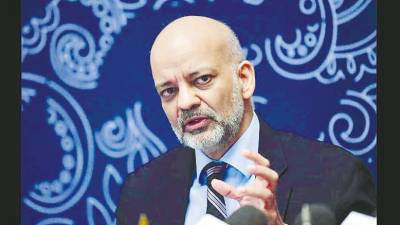KUALA LUMPUR: Malaysia’s development expenditure is projected to decline to 4.1% of gross domestic product (GDP) in 2025, down from 4.4% last year, signalling a shift that could challenge the nation’s long-term growth ambitions.
World Bank Goup lead economist for Malaysia Dr Apurva Sanghi said this marks a broader trend, whereby average annual development spending is expected to fall to 3.3% of GDP under the 13th Malaysia Plan (13MP) compared to 4.4% under the 12th Malaysia Plan.
“While fiscal consolidation is necessary, it must be done judiciously. Cutting development expenditure may provide short-term relief, but if not balanced with strategic investments, it risks constraining Malaysia’s long-term growth potential,“ Apurva told reporters in a briefing today.
The World Bank also unveiled a report titled “From Bytes to Benefits: Digital Transformation as a Catalyst for Public Sector Productivity” today.
Apurva noted that while the government has benefited from higher revenues and reduced subsidy commitments, these gains have been partially offset by reduced allocations for development and increasing debt burdens.
He also highlighted that Malaysia’s debt-to-GDP ratio has grown to 64%, a level that raises concerns about fiscal headroom.
While net new debt issuance slightly decreased last year, the cost of servicing debt is rising steadily.
“For every RM100 collected in revenue, RM16 now goes to interest payments. This is a sharp increase from less than RM10 a decade ago. Such rising interest obligations crowd out space for crucial development spending,” Apurva said.
He said this fiscal dynamic underscores the delicate balancing act policymakers must perform: sustaining investments in infrastructure, education, and innovation while also maintaining fiscal discipline.
Further, Apurva emphasised the importance of targeted and intelligent spending adjustments.
“All spending cuts are not created equal. Malaysia needs to protect and prioritise development investments that yield long-term returns, especially during economic transitions,” he said.
Following Malaysia’s shift towards fiscal tightening and reduced development expenditure, the World Bank projects that the domestic economic outlook for 2026 will remain subdued, with GDP growth forecast to hold steady at 4.1%, mirroring 2025 levels.
“We expect no acceleration in growth next year. The momentum that supported this year’s performance is slowing, and 2026 will be a year of economic restraint,” Apurva said, outlining three primary factors weighing on Malaysia’s growth trajectory.
He said the international environment remains soft, with global and regional growth decelerating, and Malaysia’s export-oriented sectors are feeling the drag.
The World Bank also forecasts export growth to remain flat at 2.9%, while import growth is expected to decelerate from 4.5% in 2025 to 3.7% in 2026. “Much of the front-loading in exports has already taken place. As that unwinds, it will serve as a moderating force on growth,” Apurva said.
He said that while domestic demand has been a key pillar of Malaysia’s recent economic resilience, its contribution is expected to taper in 2026. “Domestic demand was the main engine of growth in 2025. But that engine is now throttling down.”
The World Bank projects domestic demand growth to slow from 5.2% this year to 4.7% in 2026. Private consumption, the largest component of domestic demand, is expected to remain largely flat year-over-year.
“We do see continued support from consumption, but not at the same pace. The boost from pent-up demand and earlier policy support is waning,“ Apurva said.
Touching on tariffs, he said while the outcome of US-Malaysia trade negotiations remains uncertain, early signs suggest room for optimism.
Tariffs on Malaysian goods entering the US were recently reduced from an initially proposed 24% to 19%, indicating a potential shift in constructive dialogue between the two sides. “There is clearly an appetite on both ends to move forward in negotiations,“ Apurva said.
However, he said Malaysia’s competitive position is still vulnerable, with nearly 60% of goods Malaysia exports to the US – now subject to the 19% tariff – are also exported by countries facing lower duties.
This puts Malaysian exports at a relative disadvantage.
“Based on tariff differentials alone, Malaysia risks losing share in the US export market,” Dr Sanghi cautioned.
He said outcomes will ultimately depend on how various countries negotiate with the US, and China’s role remains a wildcard.
Particularly vulnerable is Malaysia’s electrical and electronics (E&E) sector, which has long been a key pillar of the nation’s economy.
Apurva said E&E makes up 55% of Malaysia’s total exports to the US, and even though half of those are currently exempt from new tariffs, uncertainty looms large. “There’s real concern about whether semiconductors will face full tariffs or see exemptions for US firms. Malaysia now has the highest exposure among Asean countries to future US tariffs in the E&E sector.”
Tariffs aren’t the only concern, Apurva said. Rules of origin and transhipment policies, still unannounced, add to the uncertainty. This is particularly relevant given that China is Malaysia’s largest supplier of electronics, accounting for 12% of the local value added.
Any tightening of origin rules could disrupt Malaysia’s supply chains, Apurva said.
Beyond policy risks, structural weaknesses pose a threat to the E&E sector’s long-term competitiveness.
While Malaysia has benefited from trade relocation out of China, countries like Vietnam and Thailand have gained even more.
“The smaller gains Malaysia sees from US tariffs on China are a reflection of deeper structural challenges,” Apurva explained.
One of those challenges is Malaysia’s declining share in advanced integrated circuits, especially artificial intelligence-related chips.
Other headwinds include low R&D investment and limited domestic innovation.
Malaysia’s median R&D-to-sales ratio lags behind that of Taiwan and China, and only 13–18% of patents granted locally are awarded to Malaysian residents.
“For Malaysia to strengthen its position in global value chains, it must boost innovation, invest in R&D, and regain ground in advanced chip segments,” the World Bank economist said.
As 2026 approaches, the broader outlook remains cautious.
Growth is projected to stay flat, supported moderately by domestic demand – but with diminishing contributions from its key drivers, particularly private consumption and investment, said Apurva.
